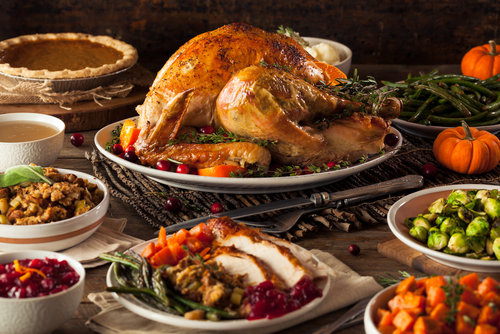Forget the Thanksgiving turducken: The cokyntryce is fit for a king
Similar bizarre dishes were being served in Europe hundreds of years ago, as hosts aimed to highlight their power and wealth.
LONDON — When it comes to Thanksgiving dinner, everyone has their own take on the classics, ranging from the traditional fare to the turducken — chicken stuffed inside duck stuffed inside turkey.
At Hebert’s Specialty Meats in Maurice, Louisiana, they’ve been making this deboned delicacy since 1984, when a customer came in with three birds and a special request to put them all together.
The turducken has proved so popular that owner Quinn Hebert says they’ll make more than 1,000 of them on Thursday, and the word was even added to Merriam-Webster’s Collegiate Dictionary in 2014.
But bizarre dishes similar to the turducken were being served in Europe hundreds of years ago, experts say.
The royal courts of Burgundy and later the Tudor court of Henry VIII strove to outdo one another with show-stopping dishes aimed to highlight the power and wealth of the host.
Kitchens at Henry VIII’s historic Hampton Court palace recently painstakingly recreated some of them using 15th century recipes, hand-made tools and old-world methods.
One of their boldest attempts is the cokyntryce — which bolted together a bird and a pig and could be considered an ancestor of the turducken.
Over a full day, two workers at the palace carefully double-stitched three parts of a pig with two turkeys, with the heads of both animals sewed onto the ends.
After using wire to position the cokyntryce in as life-like position as possible, the creation was spit-roasted for two hours on a hand-turned rotisserie, basted in a pancake batter and finally decorated and served.
“These are not everyday meals but would’ve been made for special occasions such as large feasts after a specific tournament, or treaty meetings and high holidays,” says Richard Fitch, the historic kitchens manager at Hampton Court.
He suggested ice sculptures were the modern equivalent of these expensive spectacles of the past.
When asked about how cokyntryce was to eat, Fitch quipped: “What do you think it tasted like? We’re not mucking with their DNA it’s just half a turkey and half a pig sewn together.”
He said that its stuffing or batter provided more flavor but added that “it genuinely just tastes of turkey or pig depending on what part you take.”
While the cokyntryce and similar recipes, such as the Yorkshire Christmas Pie — an 18th century combination of stuffed pigeon, partridge, turkey and goose — have fallen out of fashion in Britain, the turducken appears to have a lasting place at Thanksgiving tables.
“It’s just the thought of having a turkey, a duck and a chicken all together, it just makes people want it,” Hebert said. “If somebody likes duck, they eat the duck, if somebody don’t like duck, they can eat the chicken.”

